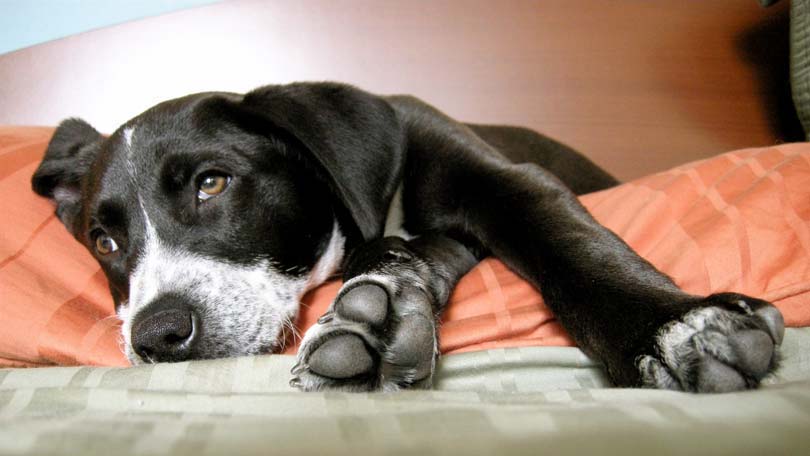
A father heading to war tells his young son he is now the man of the house and ‘to look after his mother and little sisters’. The child is left with not only the trauma of possibly never seeing his father again but with the added pressure of being given a daunting task that he is not equipped to handle.
For a dog suffering from separation anxiety, every morning is just like their owner is going off to war. They do not understand that their owners will be home eventually, unharmed and smiling, nor do they understand that all that is required of them is to relax for the day.
In the United States it is estimated that ten to fourteen percent of dogs suffer from varying degrees of separation anxiety. It is second only to aggression in behavioral disorders where owners seek treatment from professionals and an all too common reason dogs are handed over to an animal shelter by frustrated owners.
The ancestors of our domestic canines, wolves and wild dogs, live in a pack, hunt as a team and raise their young with assistance from others within the family. Rarely, if ever, is a wolf left completely alone for any more then a few minutes – even a mother left behind during the hunt will have her litter for company if not another female to help with the young. When a wolf is alone, they pace, whine, salivate, howl and make every effort to reunite with their pack even if them cause themselves harm in the process.
In our busy modern lives, it is not uncommon for our pets to be left on their own for 8 to 10 hours a day. Their ‘pack’ deserts them and just like the wolf, the worry of being left alone brings on the unique behaviors of separation anxiety.
The symptoms of separation anxiety are straight forward:
- Excessive vocalizing – whining, howling,barking
- Inappropriate urination/defecation – breaking housetraining
- Destructive behavior – digging,chewing on objects
- Self-destructive behavior – licking, chewing at skin and fur
- Depression – loss of appetite and overall listlessness
- Psychosomatic responses – excessive panting, pacing, salivating
- Overenthusiastic greetings upon owners return
- Disproportionate attachment to their human
Although it is difficult to remember when the dog has chewed through the couch or door but separation anxiety is not ‘misbehaving’. In fact it is an instinctual response to being left alone and a normal behavior if he has not been taught otherwise. Any punishment will only heighten the level of anxiety experienced next time he is left as he will be expecting to be reprimanded yet again.
Separation anxiety is most often seen in young dogs that have not been taught that being on their own is perfectly fine and that nothing will happen to them. Frequently dogs that have spent time in a shelter or abandoned can also suffer from this neurological distress response.
Mature dogs rarely develop anxiety issues unless something significantly troubling happens while they are home alone. The most common cause is a break in where the dog is roughed up or is locked in a room to keep him out of the thief’s way.
As eyesight and hearing decline, an older dog may develop separation anxiety where none was seen in years prior. It is believed that as their faculties diminish they become more dependent on their owners so the separation increases the level of distress.
The best way to treat separation anxiety is to train the pup from day one so that it never becomes an issue. Young puppies need to learn that being alone is not the end of the world and that their owners are returning. To do this, they first need to be crate trained so they are happy and confident in their kennel. Once there, the owners can now start training the pup effectively. They begin by putting on their coat, slipping on their shoes, picking up their keys and calmly stepping out the door, closing it behind them. Before the pup even registers distress, they step back into the room and give him a cookie and a ‘good boy’. This continues with more time elapsing with each instance until the pup is left alone for an hour or two without concern. He soon realizes that not only are his people coming back (a treat in itself) but that he is calmly rewarded upon their return.
Thankfully separation anxiety is almost always treatable with changing both the owners behavior and retraining the dog to understand that being alone is not the end of the world as they know it.
Owners often reinforce bad behaviors and contribute significantly to their dog’s level of distress without even realizing they are doing it. When they leave the house, they make a production of it – getting their shoes on, grabbing a coat, picking up a briefcase and giving their dog a hearty goodbye. Mornings are usually a chaotic time and there is a certain level of stress about the day ahead that a dog can easily pick up on reinforcing their belief that leaving is actually the end of the world.
No wonder the first hour a dog is left alone is when their anxiety level is at its peak. Many dogs only need to see their owners put on their shoes before they begin to stress.
Most owners make a huge fuss when they come home too, further adding to the dog’s anxiety level. It is completely natural to welcome a much loved pet when they are turning themselves inside out with excitement that their owner did indeed return to them. Calmly entering the house and ignoring the dog and its antics is best for all dogs never mind one suffering from separation anxiety (this is also a must when dealing with dominant or aggressive dogs). Think of wolves in the wild – how do the underlings react when the leader of the pack returns from the hunt? They get all excited and act submissive. And how does he react to them? He ignores them. Dogs understand body language and will react accordingly – leaving must not be a big deal since the return is almost a non-event.
Other ways to treating separation anxiety include:
- Distraction is an excellent training tool. Giving the dog a special treat a few minutes before leaving the house will divert his attention away from the departure.
- Many people believe in leaving a TV or radio on for the dog – that the sound of human voices is calming for an anxious dog. There are even DVDs that are especially made just for that reason that include clips of other dogs playing giving an anxious dog a feeling of being in a pack.
- Crate training a dog is one of the best tools for alleviating separation anxiety. Dogs love a den – they like to feel safe and an anxious dog is normally less stressed in a crate. It is best to start with him in the crate for short periods only while everyone is home so he does not associate the crate with being left.
- Exercise is another great tool for helping an anxious dog calm down. A tired dog is a happy dog and they too get an endorphin rush like humans from a good exercise session.
- Lastly a veterinarian can prescribe a drug called Clomicalm. In brief, Clomicalm is an anti-anxiety drug with anti-depressant properties. It is also formulated to help in training – it speeds up the process as well as making the animal more receptive to the work. Although it is only a tool, it is a very good one as it lessens the dog’s suffering when left alone. It is humane and highly recommended when used under the direction and advice of a veterinarian and, in cases of severe separation anxiety, an animal behaviorist.
Dogs that suffer from separation anxiety must be treated for it. They not only do damage to their environment, they more importantly do damage to themselves. Self-mutilation is an obvious concern but worse things can happen. Severe separation anxiety has led dogs to chew through doors, jump through windows, dig under kennels and escape from backyards in an attempt to reunite with their owners. An anxious dog running loose in traffic and through people’s property is a disaster waiting to happen.
Frustrating and difficult to live with, many dogs suffer or lose their lives to separation anxiety every year. It is a disease just like any other disease but one that is treatable with a little patience and knowledge. Talk to your veterinarian or an animal behaviorist for more information.





